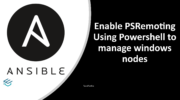#tamiltutera #ansible #why_ansible_in_tamil #ansible_in_tamil
Site: https://tamiltutera.com
Telegram Link: https://t.me/tamiltutera
Youtube Channel: https://www.youtube.com/TamilTutEra
Blog: https://tamiltutera.blogspot.com/
Like Facebook Page : https://www.facebook.com/tamiltutera
Follow us on Twitter: https://twitter.com/tamiltutera
Blog : https://tamiltutera.blogspot.com
what is Ansible?
1. It is a free open source application
2. Agent-less – No need for agent installation and management
3. Python/ yaml based
4. Highly flexible and configuration management of systems.
5. Large number of ready to use modules for system management
6. Custom modules can be added if needed
7. Configuration roll-back in case of error
8. Simple and human readable
9. Self documenting
Why Ansible?
It is a powerful and widely used open-source automation tool that can provide numerous benefits in various IT and development scenarios. Here are some reasons:
- Automation and Orchestration: It allows you to automate repetitive tasks, configurations, and processes across your infrastructure. It helps eliminate manual interventions, reducing human error and saving time.
- Infrastructure as Code (IaC): With It can define your infrastructure configurations in code, known as playbooks. This approach, often referred to as Infrastructure as Code (IaC), enables version control, consistency, and easier collaboration among teams.
- Configuration Management: It helps manage and enforce consistent configurations across your systems. This is particularly useful in environments with multiple servers, where ensuring consistency in settings can be challenging.
- Deployment and Continuous Delivery: It can be used to automate application deployments and updates. This is crucial in modern development practices like Continuous Integration and Continuous Delivery (CI/CD), where speed and reliability are essential.
- Scalability and Rapid Scaling: When your infrastructure needs to scale up or down quickly, it can help provision new resources, configure them, and integrate them into your environment seamlessly.
- Multi-Platform Support: It supports various operating systems, cloud platforms, networking devices, and more. This makes it a versatile choice for managing heterogeneous environments.
- Simplicity and Agentless Architecture: It operates using SSH and doesn’t require any agents to be installed on target systems. This simplifies deployment and reduces potential security risks associated with agent-based approaches.
- Cost-Effective: Ansible’s open-source nature means you don’t have to invest in proprietary solutions. It’s also resource-efficient, allowing you to achieve automation without significant hardware requirements.
- Reusability and Modularity: Ansible’s playbooks and roles can be modularized and reused for different tasks or projects. This saves time and effort by allowing you to build on existing automation code.
- Compliance and Security: It can help you maintain compliance by enforcing security policies and configurations consistently across your infrastructure.
- Adaptability: It can be integrated into existing tools, processes, and workflows, making it a flexible choice for organizations with diverse technology stacks.
Documentation: https://docs.ansible.com
Playlists:
https://www.youtube.com/playlist?list=PLMajL6JMRh6SUYi8yogexoap4CXzFaI7y
Ansible in Tamil – 01 – Ansible Introduction in தமிழ் | Ansible DevOps Tutorial in Tamil | Ansible
https://youtu.be/CPSC6X5S5_o
Ansible in Tamil – 02- Why Ansible? in Tamil | Ansible in தமிழ் | Ansible DevOps Tutorial in Tamil
https://youtu.be/GVzSjnXkSiU
Ansible in Tamil – 03 – Advantages in தமிழ் | Ansible in தமிழ்| Ansible DevOps Tutorial in தமிழ்
https://youtu.be/QARxogodRBM


